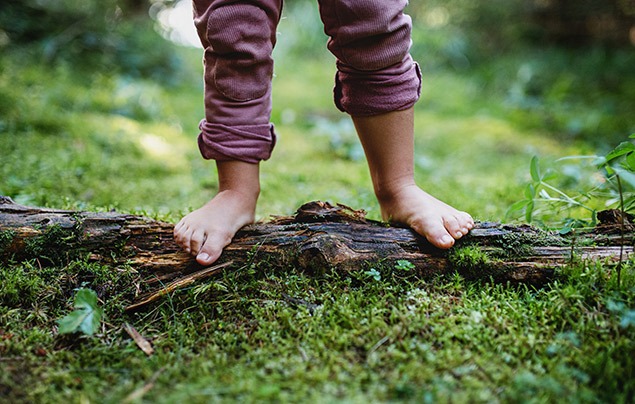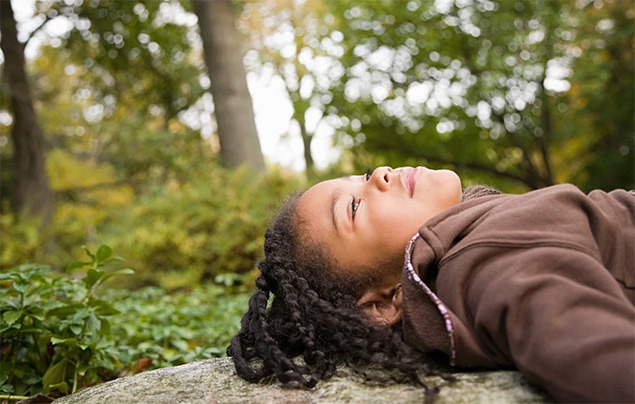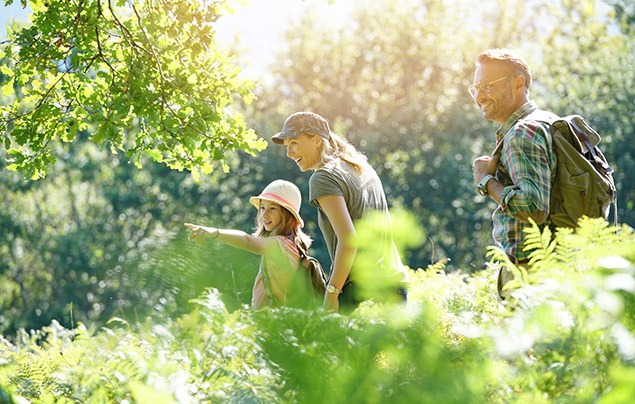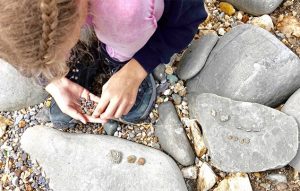De-stress your kids with a forest bathing adventure
Get the family outside and support their wellbeing with this Japanese practice!
Imagine a sunny spring day. You walk in a beautiful, dappled woodland, feeling the soft breeze on your skin and hearing birds twitter above you. What do you feel? How many colours can you count? Do you hear the murmur of buzzing bees, or rustling of trees in the wind?
Paying close, peaceful attention to your surroundings can turn a brisk walk in the woods into a meditative sensory experience, according to forest bathers like primary school teacher Ruth Nazarian.
“When you really pay attention to nature with kids, so many ordinary things become magical,” says Nazarian, a certified forest therapy guide.
What is forest bathing?
This is the practice of shinrin-yoku, or forest bathing, which was officially recognised by the Japanese government in the 1980s. It’s different from hiking, which is about reaching a destination, or taking a nature walk, which focuses on identifying plants and animals. Forest bathing encourages participants to engage with nature slowly and deliberately.
You can try this nature-based practice no matter where you live — and it has tangible physical and mental health benefits for kids.
The benefits of forest bathing
Forest bathing is all about soaking in your surroundings and practicing mindfulness while in nature, whether it’s your backyard, local park, or an actual forest. And a growing body of research shows it has health benefits ranging from better sleep to reductions in the stress hormone cortisol.
This may be because forest bathing essentially combines the benefits of meditation with the benefits of being outside in nature. For example, forest bathing and meditation are both mindfulness practices that help you become fully engaged in the present moment. Studies show that cultivating mindfulness can boost memory and focus, promote empathy, reduce stress, and improve attention and behaviour in school.
But traditional meditation can be challenging, especially for younger kids who have trouble sitting still.
“Forest bathing activities pull us into the present moment without needing to be still,” Nazarian explains. “This helps children become more aware of their bodies. As they learn to be aware of how their body feels, they start to recognise how their bodies react to emotions as well. It’s a valuable strategy to self-soothe and manage stress.”
Out in nature
Then there’s the other advantage of forest bathing: it gets kids outside and into green spaces. Hundreds of studies have investigated the positive impacts of nature on children’s physical, mental, and emotional health and development — ranging from boosting kids’ IQ and strengthening familial bonds to improving mental health. Plus, it’s a great way to cut down on screen time and combat eco-anxiety with a positive connection to nature.
“There is something about being in the natural world that improves cognitive development and physical and mental health,” says Richard Louv, co-founder of the Children and Nature Network and author of several books, including Last Child in the Woods: Saving Our Children from Nature-Deficit Disorder. “Specifically, the research strongly suggests time in nature can help children learn to build confidence, teach them to calm themselves, improve focus, improve creativity and reduce stress.”
Developing a connection with the natural world is mutually beneficial, too. Kids thrive on time outdoors, and developing a love for nature will inspire them to care for it in the future. Spark their imagination with tales of explorers and scientists from a National Geographic Kids magazine subscription, then take them out for an adventure of their own.
A beginner’s guide to forest bathing
Ready to try forest bathing with your kids? Here are a few guidelines to get you started.
Be flexible.
Helene Gibbons, a forest-bathing guide, has adapted many practices into five- to 15-minute breaks that teachers can do with children throughout the day. “It’s not always realistic to do an hour-long forest-bathing walk with kids,” she says.
Shortening the amount of time you focus on a forest-bathing activity is one way to keep it loose, particularly for younger children. Giving them permission to talk and move around, regardless of the activity, is another way to be more flexible.
“We call the activities ‘invitations’ because you’re always welcome to adapt them,” Gibbons says. “Kids need autonomy to make decisions for themselves. They like to have that freedom.”
Draw attention to the sensory experience.
“Using your senses is all about noticing your surroundings, being alert, and being present—things that meditation does as well,” says Katy Bowman, a bio-mechanist and author of Grow Wild: The Whole-Child, Whole-Family, Nature-Rich Guide to Moving More.
“When you’re listening for all the nature sounds you can hear, you’re focused on something that’s not the jibber jabber in your own head,” she says.
Ask questions that encourage children to focus on their senses. What does the grass feel like? Can you see different shapes? Take a deep breath – what do you smell?
Turn it into a game.
These activities help provide a fun, loose structure that encourages children to be more mindful of their natural surroundings:
- – Use a rope or hula hoop to create a circle in the grass. Then encourage children to explore the small area with a magnifying glass.
- – In the ‘What’s in Motion’ game, Nazarian asks kids to walk very slowly and notice what’s in motion while they’re in motion. Often they’ll notice big movements like birds, then smaller ones like ants. “One time a breeze came through and dispersed hundreds of helicopter seeds,” she says. “We had been stepping on them for weeks but paying attention to them floating above our heads was delightful.”
- – To extend the immersion, try the Camera Game. One kid is the photographer, and the other is the camera. The camera closes his or her eyes, and the photographer guides the camera to a natural scene like a tree trunk. When the photographer signals, the camera opens his or her eyes and captures as much detail of the scene as possible. Depending on the age of your child, encourage them to write about or draw what they see.
- – Lie on your back, watch the clouds float by and see what shapes and images you see.
- – For a rainy-day activity, Gibbons suggests sitting by an open window and listening to the rain for a few minutes. Then have kids draw a picture of how they feel.
Look out for more ways to connect your kids with nature in National Geographic Kids’ free email newsletter. It’s packed with family-friendly activities, good news and more!
















LEAVE A COMMENT
THANK YOU
Your comment will be checked and approved shortly.
WELL DONE,
YOUR COMMENT
HAS BEEN ADDED!
COMMENTS
CUSTOMIZE YOUR AVATAR